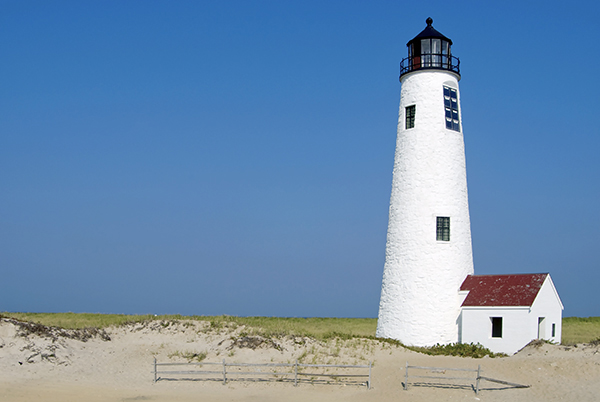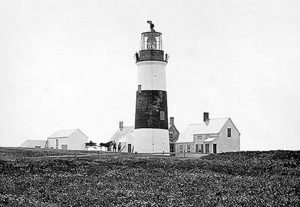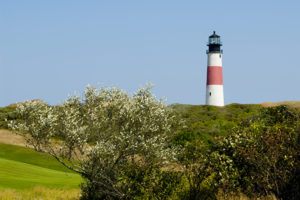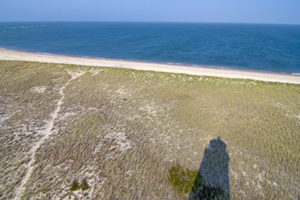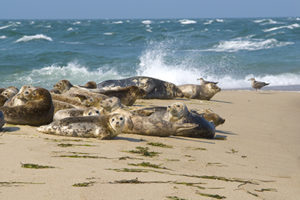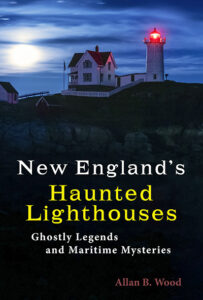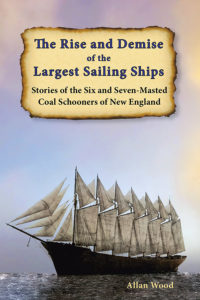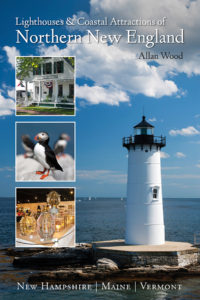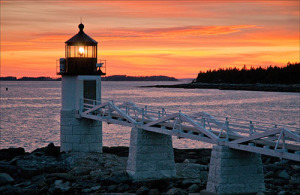Grueling Rescue of the H.P. Kirkham by the Coskata Lifesavers by Great Point Lighthouse on Nantucket Island, in a January Storm Near Sankaty Head Lighthouse
The Coskata Lifesaving Station was built in 1883 on Nantucket Island’s Coskata Beach, about two miles south of Great Point lighthouse. Lifesaving stations were built a few miles beyond a particular stationed lighthouse for rescue operations a distance from shore that usually involved shipwrecks, as lighthouse keepers themselves had to remain near the lighthouse at all times and had minimal rescue equipment, which was used mainly for rescues close to the shore and the lighthouse. Lifesaving stations specifically trained their mostly volunteer “soldiers of the surf,” more commonly referred to as “surfmen,” in rescue techniques with near-daily drills, and shore patrols would go out for miles at either side of the lighthouse to be on the lookout for wrecks, or victims in distress, especially during or after a storm. Dangerous shoals off the eastern coast of Nantucket created many shipwrecks. The Rose and Crown Shoal were the most dangerous, some 15 miles offshore. Other shoals include the Great Rip Shoal, and the Bass Rip Shoal, to the southeast of the village of Siasconset. One of the most grueling rescues occurred when Keeper Walter N. Chase and his six-man Coskata life-saving crew were involved in the rescue of the crew of the H.P. Kirkham, which was sinking off of Nantucket Island in a winter storm. On the eve of January 15, 1892, a bitter wind from the north approached the area, followed by snow and sleet as the temperature plummeted well below zero. The H.P. Kirkham was a British three-masted schooner sailing from Halifax, Nova Scotia, bound for New York. The vessel carried a load of salt and pickled fish with her crew. She became caught in the storm and was battling through heavy seas when she became lost in the blizzard. By seven o’clock the following night of January 16, 1892, she hit the Rose and Crown Shoal. The captain put out a distress signal using torches, and he set his crew to attach themselves to the rigging to wait for help as the storm continued. Early the following day, Keeper Chase of the Coskata Life Saving Station answered a call from lighthouse keeper Joseph Remsen at Sankaty Head, who told him that just before dawn, he had seen torch flashes and believed he could see the masts of a vessel on Bass Rip, ten miles out from shore. Chase sounded the alarm and made haste with his surfmen to launch a rescue boat. The wind was to their backs, and they could make it to Bass Rip, another dangerous shoal, but they realized the wreck was another five miles away by the Rose and Crown Shoal. The keeper and his men continued towards the wreck, braving the freezing temperatures and rough seas, again with the howling winds filling their sails. When the lifesavers got near enough, they observed seven men clinging to the rigging. They could see the schooner had already worked itself so deeply into the treacherous shoal that it would soon break apart as waves continued to pound and wash over the wreck. The seas were finally getting calmer as Chase and his men steadied the boat, got a heaving stick and line to the crew, and fastened the line back to his boat. The sailors from the wreck were frozen and frightened as they hauled the boat towards the wreck so rapidly that they were in danger of swamping the craft. Keeper Chase ordered them to make the line fast, but the undisciplined crew of the schooner didn’t obey his command. Fearing for the safety of his crew, the keeper passed his knife to the stroke oarsman and shouted to the frightened sailors of the H.P. Kirkham that he would cut the line if they pulled the boat any closer. The terrified sailors heeded the keeper’s warning as the lifeboat was brought in as close to the wreck as safely as possible. One after another, Chase’s men took the seven men off the wreck and positioned them inside their boat. The problem Keeper Chase now faced was a headwind towards the shore, as he decided to take down the mast and sail. The storm started to pick up again, and they could see the powerful light of Sankaty Head Lighthouse. They decided to make the closer distance to the beacon. After three hours of hard pulling, they passed the Bass Rip shoal but could make no further headway into the storm. They decided to anchor the lifeboat, waiting for the turn of the tide that might help them reach land. As the seas continued to thrash the boat, the tide broke around 9 P.M., but the storm hampered their efforts after an hour, and the crew had to anchor again and wait the night out. By sunrise on January 17, the tide came up, and the seas and winds were starting to calm as the men made another pull for the shore. They reached Siasconset Beach, near the lighthouse, on the southeastern shore of Nantucket by 10 AM, after 26 hours of having been out at sea. After a brief stay at the lighthouse to warm themselves, they still had to travel eight miles across the island to the Coskata Life Saving Station and, out of pure exhaustion, made it to the station by late afternoon. The crewmen of the H.P. Kirkham all survived the wreck, and Keeper Chase and his crew were awarded lifesaving medals months later, although some had succumbed to various stages of frostbite. Surfman Roland H. Perkins, one of the crew, who came down with consumption from the ordeal and battled with pneumonia a few months before the rescue, died a couple of months after receiving his medal.Exploring Nantucket Island, its Lighthouses, and Coskata-Coatue Wildlife Refuge
Nantucket Island, off Cape Cod in Massachusetts, is a relatively quiet island that offers many pristine beaches, quaint shops, historic Victorian homes, and beautiful harbors, with local restaurants for those who have come to relax and enjoy the views. There are also no streetlights on Nantucket Island. The Nantucket Regional Transit Authority (The WAVE) provides bus service throughout the island. The island has three lighthouses: Brant Point, Sankaty Head, and Great Point. Brant Point Lighthouse, with its surrounding harbor side park, visitors will find just a short walk from the ferry dock. There is also a quiet beach there facing the harbor. Great Point lighthouse is located on the extreme northeastern tip of Nantucket, in the Coskata-Coatue Wildlife Refuge. The park’s rangers allow public access to the tower and surrounding grounds on many nature tours during the summer months. There, a naturalist guide will lead visitors on an over-sand vehicle tour through the salt marsh to learn about the area’s geology, ecology, and history and to climb the Great Point Lighthouse tower (great views!). About a mile north of the village of Siasconset and its local beaches, Sankaty Head Light sits adjacent to the 9-hole Siasconset Golf Course which practices “pasture golf” so visitors can play dressed as they are and enjoy the views by the lighthouse. Visitors can also explore the Nantucket Whaling Museum and Nantucket Shipwreck and Life Saving Museum, which provides more info on the H.P. Kirkman Rescue and plenty of vintage maritime artifacts. Explore the Maria Mitchell Observatories. Enjoy your summer! Allan WoodBooks to Explore
New England’s Haunted Lighthouses: Ghostly Legends and Maritime MysteriesDiscover the mysteries of New England’s haunted lighthouses! Uncover ghostly tales of lingering keepers, victims of misfortune or local shipwrecks, lost souls, ghost ships, and more. Many of these accounts begin with actual historical events that later lead to unexplained incidents.
Immerse yourself in the tales associated with these iconic beacons! The Rise and Demise of the Largest Sailing Ships: Stories of the Six and Seven-Masted Coal Schooners of New England. In the early 1900s, New England shipbuilders constructed the world’s largest sailing ships amid social and political reforms. These giants were the ten original six-masted coal schooners and one colossal seven-masted vessel, built to carry massive quantities of coal and building supplies and measured longer than a football field! This self-published book, balanced with plenty of color and vintage images, showcases the historical accounts that followed these mighty ships. Available also from bookstores in paperback, hardcover, and as an eBook for all devices.
Book – Lighthouses and Coastal Attractions in Southern New England: Connecticut, Rhode Island, Massachusetts
